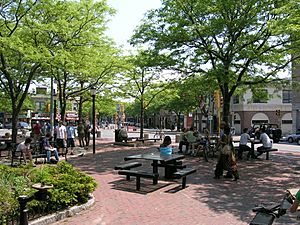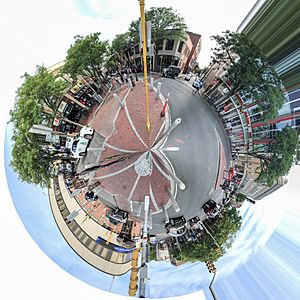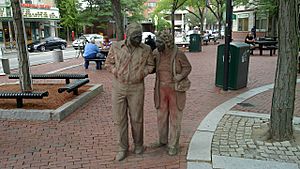Davis Square facts for kids
Davis Square is a busy meeting point in Somerville, Massachusetts. Many streets come together here, like Holland Street, Dover Street, Day Street, Elm Street, Highland Avenue, and College Avenue. People often use the name "Davis Square" to talk about the whole neighborhood around this intersection.
Davis Square is about four miles from downtown Boston. It's also two miles from central Cambridge. You can easily get there using the Massachusetts Bay Transportation Authority (MBTA)'s Red Line subway, which has a stop called Davis Square Station. Davis Square is close to other neighborhoods like Powder House Square, Magoun Square, Spring Hill, and Tufts University.
Today, Davis Square is a lively place with many shops, restaurants, and places to go out. You can find all sorts of businesses here, from stores to martial arts schools. After World War II, Davis Square became less popular. But when the Red Line subway was extended to Davis in the mid-1980s, the area started to become popular and successful again.
History of Davis Square
The City of Somerville officially named Davis Square in 1883. It was named after Person Davis (1819-1894). He was a grain dealer who moved to the area in 1850. He built his home near where Elm, Grove, and Morrison Streets meet. Person Davis was also a local leader in Somerville. In the 1860s and 1870s, roads got better and train connections grew stronger. This helped West Somerville become a more developed city area.
After the Civil War, from 1870 to 1910, many people chose to live in West Somerville. There was plenty of land for new homes, both small and large. It was also easy to travel to Boston for work because of the train lines. By 1857, horse-drawn streetcar lines reached from Harvard Square to Arlington. In 1863, another company connected Union Square with West Somerville. Passenger trains arrived in 1870. The Lexington and Arlington Railroad (later the Boston and Maine Railroad) ran through Davis Square. These improvements helped Davis Square grow quickly into a busy shopping area in the 1870s and 1880s. Many new homes were built in the 1890s.
Brick roads were put in Davis Square in 1900. The area stayed a busy place for shopping and transportation until after World War II. At that time, many people started moving to the suburbs. Cities across the country began to decline. In 1914, the Somerville Theatre opened, showing silent films and live performances. In 1927, the trains that brought many people to Davis Square were rerouted. This also made Davis Square decline in the middle of the 20th century. Factories closed, businesses failed, and residents moved away. Davis Square ended up with many empty stores and run-down areas. A study in 1980 said Davis Square had problems like traffic, not enough parking, and old buildings.
Things started to get better in the late 1970s. This was thanks to the Somerville Office of Planning and Community Development and the Davis Square Task Force. Their hard work led to the Davis Square Action Plan, which was approved in 1982.
At the same time, local leaders and citizen groups asked the Massachusetts Bay Transportation Authority (MBTA) to add a Red Line subway stop in Somerville. The MBTA agreed. In 1977, business owners and residents formed the Davis Square Task Force. This group advised on plans to make the community better. By the early 1980s, ideas for new public spaces, jobs, housing, and safe walking paths became part of the discussions about the new train station.
With help from the Davis Square Task Force, the city made the Red Line station the main part of its plan to improve the downtown area. The goal was to help businesses while keeping the neighborhood's homey feel. The 1982 Davis Square Action plan led to projects like the Somerville Community Path, the Harvard Vanguard office building, a parking garage, and senior housing.
The center of Davis Square is a complex, busy intersection where six streets meet. This area was completely changed as part of the plan. Before, two big streets cut through the square, making it hard for people to walk. New crosswalks, sidewalks, and safe walking areas were added. Also, several freight trains used to run through the square every day. This would stop traffic for a long time.
The MBTA built a central plaza connecting the two station entrances. This plaza was built on the old train tracks. It replaced an undefined open area that had parking spaces and debris. The plaza was designed to be the heart of Davis Square. It became a gathering place for activities and outdoor entertainment. Money was set aside for public art projects for the plaza and station. This led to several sculptures, including the Davis Square statues.
The city of Somerville and the Task Force started many other projects. These went along with the Red Line extension and Davis Square improvements. They offered grants to improve storefronts and building exteriors. They also helped finance building renovations. Part of Davis Square was chosen as an area for special improvements. Within this area, properties were bought, cleared, and upgraded.
This area later became a large complex with offices and stores. It also included public open space and a parking garage for local businesses.
In 1997, the Utne Reader magazine called Davis Square one of the fifteen "hippest places to live" in the United States. This reputation has continued. In 2016, a real estate company rated Davis Square as one of the "Top 100 Cool Streets" in North America.
In 2005, The Boston Globe newspaper reported the first million-dollar condo sale in Davis Square. This was a big change for a neighborhood once known for being affordable and working-class. Now, it has some of the most expensive homes in Somerville. It is much more costly than the average for eastern Massachusetts.
Transportation
Davis Square is served by the Red Line subway. This line was extended from Harvard to Alewife in the 1980s. The Davis station opened on December 8, 1984. Davis Square also connects to several MBTA bus lines that go to nearby towns.
As part of the Davis Square Plan, the old Boston and Maine Railroad tracks were turned into a mixed-use path. This path is known as the Somerville Community Path. Most of the old railroad tracks between Davis Square and the Red Line's end at Alewife were redeveloped. They became a long park or a path for bikes and walkers. A public park was built behind the Holland Street MBTA station entrance later on. The Alewife Linear Park connects Alewife MBTA station with the Minuteman Bikeway. This is a 10-mile bike path that goes to Bedford.
Arts and Culture
As Somerville continues to grow, Davis Square has been a leader in its improvements. Over the past thirty years, Davis has become a lively center for shopping, nightlife, and dining. It's a great place for businesses, with over 200 companies. These include healthcare, tech companies, non-profits, and media offices. Boston Magazine noted in 2012 that several food and entertainment places from before the Red Line extension were still open. These include the Somerville Theatre, The Rosebud, McKinnon's Meat Market, and a candlepin bowling alley.
The Somerville Theatre shows movies and hosts live performances. It also has a small gallery from the Museum of Bad Art. The Public Radio International show, Living on Earth, is recorded in its studios in Davis Square. For five years, the Jimmy Tingle Off-Broadway Theater hosted many famous comedians and musicians. It closed in October 2007.
Davis Square hosts several popular festivals and events each year. The Somerville Arts Council's ArtBeat festival happens here every July. The HONK! Festival of activist brass bands takes place every October. During the summer, there are free public folk dances.






